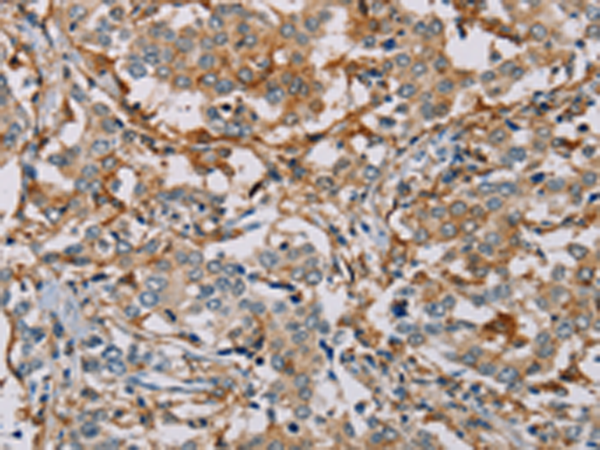
| WB | 咨询技术 | Human,Mouse,Rat |
| IF | 咨询技术 | Human,Mouse,Rat |
| IHC | 1/25-1/100 | Human,Mouse,Rat |
| ICC | 技术咨询 | Human,Mouse,Rat |
| FCM | 咨询技术 | Human,Mouse,Rat |
| Elisa | 1/1000-1/2000 | Human,Mouse,Rat |
| Aliases | SRA; SR-A; CD204; phSR1; phSR2; SCARA1 |
| Host/Isotype | Rabbit IgG |
| Antibody Type | Primary antibody |
| Storage | Store at 4°C short term. Aliquot and store at -20°C long term. Avoid freeze/thaw cycles. |
| Species Reactivity | Human, Mouse |
| Immunogen | Fusion protein of human MSR1 |
| Formulation | Purified antibody in PBS with 0.05% sodium azide and 50% glycerol. |
+ +
以下是关于MSR1抗体的3-4篇参考文献的简要概括(注:以下内容为示例,实际文献需通过学术数据库验证):
1. **文献名称**:*Targeting MSR1 in tumor-associated macrophages enhances anti-tumor immunity*
**作者**:Komohara Y, et al.
**摘要**:研究通过MSR1抗体阻断肿瘤相关巨噬细胞(TAMs)中的MSR1功能,发现其能抑制肿瘤生长并增强PD-1免疫治疗的响应,揭示了MSR1作为肿瘤免疫治疗靶点的潜力。
2. **文献名称**:*MSR1 antibody-mediated modulation of atherosclerosis in a murine model*
**作者**:Yu X, et al.
**摘要**:开发了一种人源化MSR1单克隆抗体,实验显示其通过抑制巨噬细胞对氧化低密度脂蛋白(oxLDL)的摄取,显著减少动脉粥样硬化斑块形成,为代谢性疾病治疗提供新策略。
3. **文献名称**:*Scavenger receptor MSR1 contributes to bacterial clearance via antibody-mediated phagocytosis*
**作者**:Canton J, et al.
**摘要**:研究发现MSR1在巨噬细胞识别和吞噬细菌过程中起关键作用,使用MSR1抗体阻断受体后,宿主对金黄色葡萄球菌的清除能力下降,提示其在感染免疫中的功能。
4. **文献名称**:*MSR1 as a regulator of adipose tissue inflammation in obesity*
**作者**:Zhu L, et al.
**摘要**:通过MSR1抗体干预肥胖小鼠模型,发现其可减少脂肪组织巨噬细胞浸润及炎症因子释放,改善胰岛素抵抗,表明MSR1抗体在代谢综合征中的治疗价值。
建议通过PubMed、Google Scholar等平台核对具体文献细节及最新研究进展。
MSR1 (Macrophage Scavenger Receptor 1), also known as SR-A1 or CD204. is a transmembrane glycoprotein primarily expressed on macrophages and dendritic cells. It belongs to the class A scavenger receptor family, characterized by its ability to bind modified low-density lipoproteins (e.g., oxidized LDL) and pathogen-associated molecular patterns. Structurally, MSR1 features a collagen-like domain, a coiled-coil α-helical spacer, and a cysteine-rich C-terminal domain. Its broad ligand specificity enables roles in lipid metabolism, innate immunity, and clearance of cellular debris.
First identified in the 1990s, MSR1 gained attention for its involvement in atherosclerosis through foam cell formation, where macrophages internalize oxidized lipids. However, studies later revealed its dual role in both pro-inflammatory and anti-inflammatory responses, depending on context. It participates in bacterial recognition, apoptotic cell phagocytosis, and modulation of Toll-like receptor signaling.
MSR1 antibodies are valuable tools for studying macrophage biology and disease mechanisms. They are used to detect receptor expression in tissues (e.g., tumor-associated macrophages) and to investigate functional roles in cancer, neurodegenerative diseases, and chronic inflammation. Therapeutic applications are being explored, with some antibodies targeting MSR1 to modulate macrophage activity in tumors or inflammatory disorders. However, challenges remain in understanding isoform-specific functions and ligand-receptor dynamics, as alternative splicing generates multiple MSR1 variants with distinct properties.
×